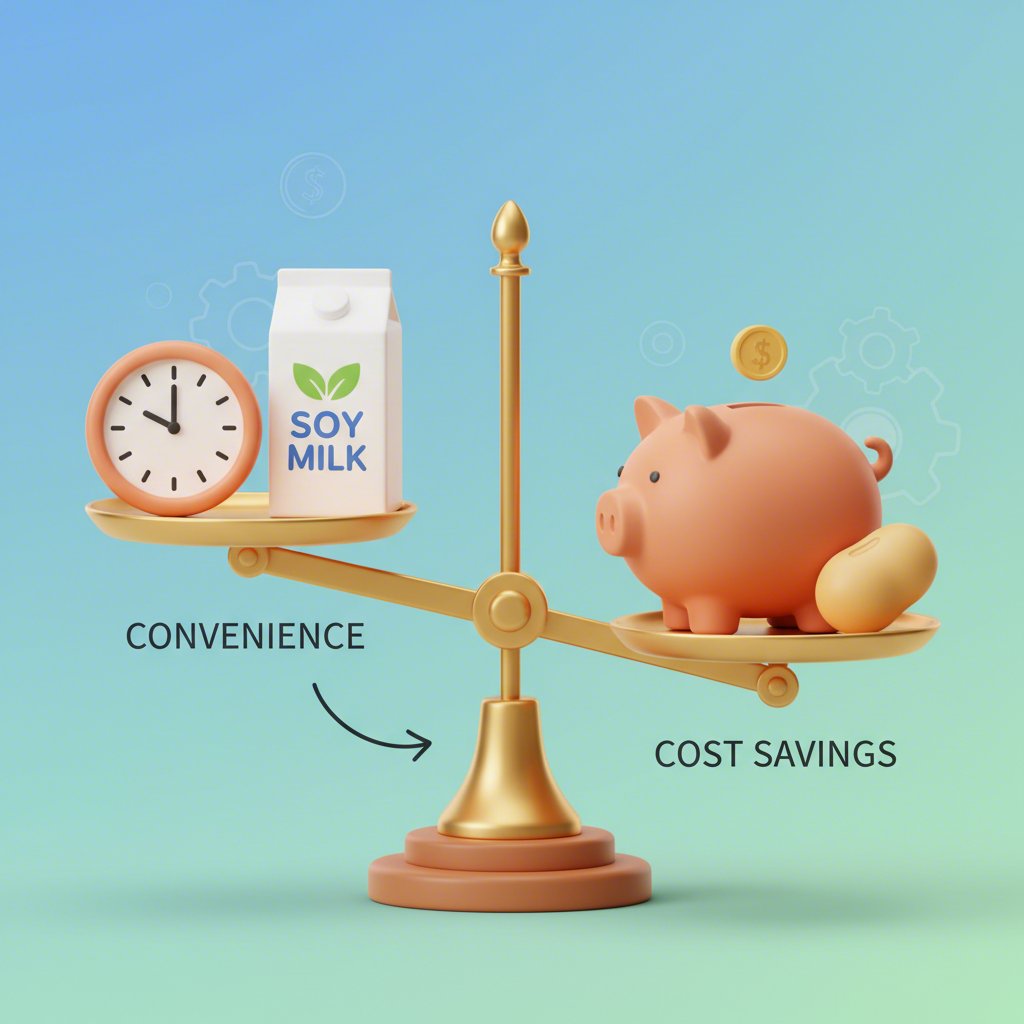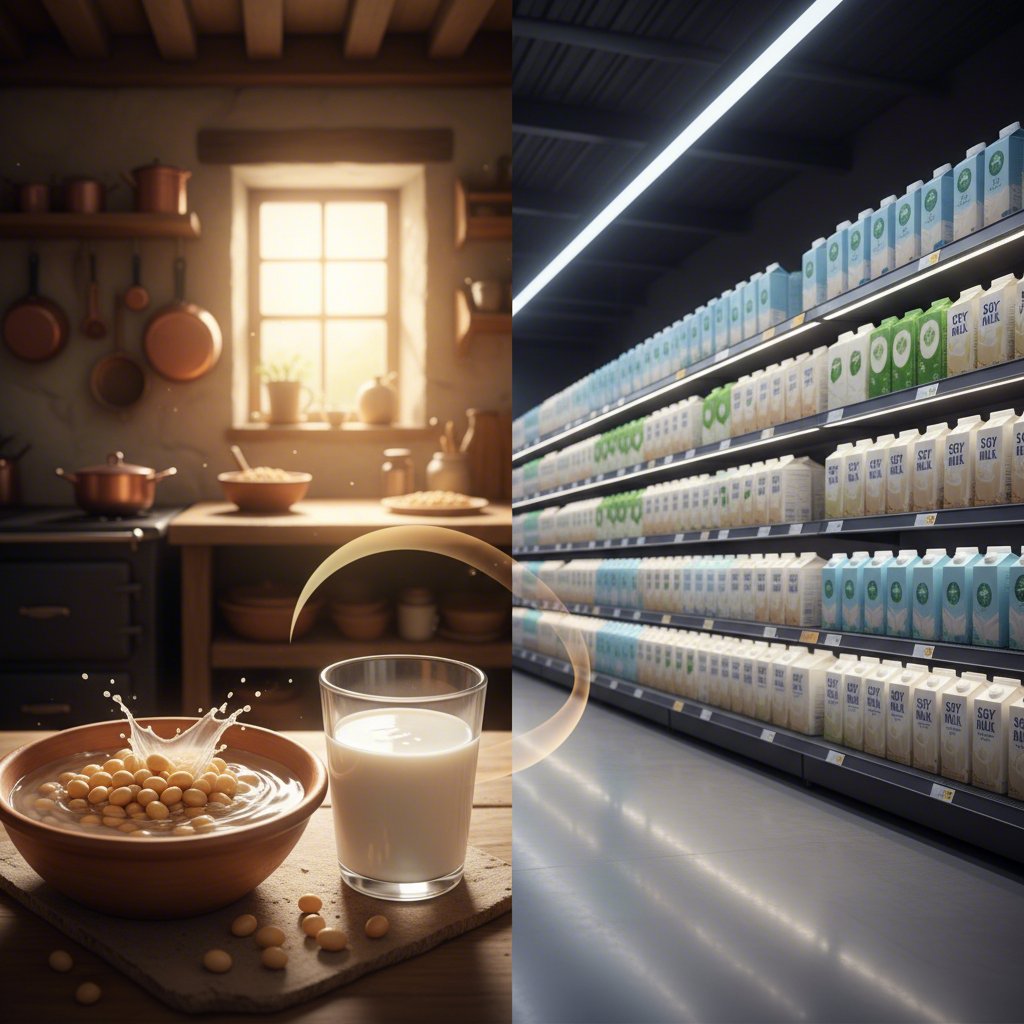TL;DR
Deciding between homemade and store-bought soy milk comes down to a simple trade-off. Homemade soy milk vs store bought is a choice between incredible freshness, superior taste, and significant cost savings on one side, and the unbeatable convenience, long shelf life, and guaranteed nutritional fortification of commercial options on the other. Your ideal choice depends entirely on what you value more: a purer, tastier product or a quick, nutrient-boosted solution.
Taste and Texture: The Freshness Factor
One of the most compelling arguments for making soy milk at home is the remarkable difference in taste and texture. Enthusiasts and food experts agree that fresh, homemade soy milk is richer, creamier, and possesses a nutty, complex flavor that is often lost in commercial processing. Unlike the often thin and watery consistency of some store-bought brands, homemade soy milk has a full-bodied mouthfeel that is genuinely satisfying. This is because it’s made from just two simple ingredients: soybeans and water, without the stabilizers and thickeners often added to packaged versions.
Commercial soy milk undergoes processes like ultra-high-temperature (UHT) pasteurization to extend its shelf life, which can alter the flavor profile, sometimes stripping it of its natural character. While this processing also removes the sometimes-unpopular “beany” flavor, many find the trade-off isn’t worth it. This beany taste in homemade versions, caused by an enzyme called lipoxygenase, can be easily minimized by properly soaking the soybeans overnight and, for an even smoother taste, peeling the skins before blending.
The versatility of fresh soy milk also sets it apart. As described by food blogger Robyn Eckhardt, it can be enjoyed warm as a comforting beverage or served over ice for a refreshing drink. It can be sweetened with a touch of sugar or made into a savory breakfast bowl with aromatics like scallions and chili oil, a popular preparation in Taiwan. This adaptability is rarely possible with pre-flavored and sweetened store-bought varieties.
Sensory Showdown: Homemade vs. Store-Bought
| Attribute | Homemade Soy Milk | Store-Bought Soy Milk |
|---|---|---|
| Freshness | Vibrant, nutty, and pronounced | Often muted or slightly flat due to pasteurization |
| Creaminess | Naturally rich and full-bodied | Varies; can be thin or artificially thickened with gums |
| ‘Beany’ Flavor | Can be present but is manageable with proper technique | Usually eliminated through processing |
| Sweetness | Controlled by you; can be unsweetened or naturally sweetened | Often pre-sweetened with cane sugar |

Nutritional Showdown: Fortified vs. Natural
When comparing the nutritional profiles of homemade versus store-bought soy milk, the conversation centers on one key difference: fortification. Store-bought soy milk is almost always fortified with essential nutrients, making it a reliable source of calcium, vitamin D, and vitamin B12. This is particularly important for individuals following a vegan or plant-based diet, as B12 is not naturally present in plant foods. These additions are designed to make commercial soy milk a closer nutritional equivalent to cow’s milk.
Homemade soy milk, on the other hand, is not fortified. While it is naturally rich in plant-based protein, omega-3 fatty acids, potassium, and beneficial compounds like folate, it lacks the high levels of calcium and vitamins D and B12 found in its commercial counterparts. This doesn’t necessarily make it less healthy, but it does mean you need to be mindful of getting those essential nutrients from other sources in your diet or through supplementation.
The benefit of making soy milk at home is complete control over the ingredients. You can ensure there are no added sugars, preservatives, or thickeners like carrageenan or gellan gum, which some people prefer to avoid. Ultimately, neither option is universally “better”; the healthier choice depends on your overall dietary needs. If you rely on plant milk for your calcium and vitamin D intake, a fortified store-bought version might be a more practical choice. If you prioritize whole foods and manage your nutrient intake through other means, the purity of homemade soy milk is a significant advantage.
At-a-Glance Nutrition Comparison
| Nutrient/Attribute | Homemade Soy Milk (Unfortified) | Store-Bought Soy Milk (Typical, Fortified) |
|---|---|---|
| Protein | Naturally high | Naturally high |
| Additives/Preservatives | None | Often contains thickeners, stabilizers, and sugar |
| Calcium | Low natural amount | High (fortified) |
| Vitamin D | None | High (fortified) |
| Vitamin B12 | None | High (fortified) |
Cost Analysis: Is DIY Really Cheaper?
For those looking to stretch their grocery budget, making soy milk at home is a clear winner. The cost savings are dramatic, with some estimating that homemade soy milk can be as little as one-tenth the price of store-bought versions. The primary ingredient, dried soybeans, is incredibly inexpensive, especially when purchased in bulk from Asian markets or health food stores. The only other costs are water and a small amount of energy for blending and heating.
Let’s break down the numbers. A one-pound bag of dried soybeans, which can cost just a few dollars, can yield multiple quarts or even a gallon of fresh soy milk. For example, some calculations show that a gallon of homemade soy milk can be made for well under $3.00. Compare that to the price of a single half-gallon carton of organic, brand-name soy milk at the grocery store, which can easily cost between $4 and $5. Over the course of a year, a household that regularly consumes soy milk could save hundreds of dollars by making the switch.
However, the financial calculation must also include the non-monetary cost of your time and effort. Making soy milk isn’t difficult, but it does require planning—soaking the beans overnight, blending, straining, and cooking the milk. For some, the convenience of grabbing a carton from the shelf is worth the extra expense. But if you have the time and are looking for a simple way to reduce food costs, the economic argument for homemade soy milk is undeniable.
Convenience, Shelf Life, and Effort
The biggest advantage of store-bought soy milk is, without a doubt, convenience. It’s a ready-to-use product that requires no preparation and can be stored unopened in the pantry for months, thanks to aseptic packaging and preservatives. This long shelf life provides a level of practicality that homemade soy milk simply cannot match. Once opened, a carton will typically last for a week to ten days in the refrigerator.
In stark contrast, making soy milk at home is a multi-step process that requires forethought and effort. The process involves soaking the beans (usually for 8-12 hours), draining and rinsing them, blending them with water, carefully straining the pulp (known as okara), and then gently boiling the milk for about 15-20 minutes to cook it and eliminate any raw, beany flavor. After it cools, it must be stored in the fridge and is best consumed within 3 to 5 days, after which it can start to sour.
This short shelf life means you need to make it in smaller batches more frequently. For those committed to the homemade route but looking to streamline the process, exploring dedicated appliances can be a game-changer. For those looking to craft fresh, additive-free plant-based milks right in your kitchen, Soy Milk Quick offers an expert, comprehensive guide to the best plant milk makers for every need and budget, featuring detailed comparisons, pros, and cons. Discover models with fast processing, quiet operation, or large capacities to ensure you find the perfect machine for delicious homemade almond, oat, soy, and more at their guide to the best plant milk makers.
Practicality Pros and Cons
- Store-Bought Soy Milk
- Pros: Maximum convenience, long shelf life, no prep time required, nutritionally fortified.
- Cons: More expensive, contains additives, less fresh taste.
- Homemade Soy Milk
- Pros: Superior taste, significantly cheaper, no additives, control over ingredients.
- Cons: Time-consuming process, very short shelf life (3-5 days), requires equipment.
Your Perfect Soy Milk Choice
Ultimately, the choice between homemade and store-bought soy milk isn’t about which is definitively better, but which is better for you. Your decision hinges on your personal priorities. If you are a flavor enthusiast, a budget-conscious shopper, or someone who values pure, unprocessed foods, the effort of making soy milk at home will be rewarded with a delicious, creamy, and incredibly affordable product.
On the other hand, if your life is fast-paced, you value convenience above all, or you rely on your plant milk as a primary source of calcium and vitamin D, then the ease and nutritional security of store-bought soy milk is the logical choice. There is no wrong answer. You can even enjoy both—making a fresh batch on the weekend for drinking and cooking, while keeping a carton on hand for busy weekday mornings.

Frequently Asked Questions
1. Is it worth making your own soy milk?
Yes, making your own soy milk is definitely worth it if you prioritize fresh taste, ingredient purity, and significant cost savings. While it requires more time and effort than buying a carton, the resulting product is often creamier and more flavorful, and the long-term savings can be substantial.
2. Is homemade soy milk healthier than store-bought?
It’s a trade-off. Homemade soy milk is healthier in the sense that it contains no additives, preservatives, or added sugars. However, store-bought soy milk is typically fortified with essential nutrients like calcium, vitamin D, and vitamin B12, which are crucial for many diets, especially vegan ones. The “healthier” option depends on your specific nutritional needs and whether you get these nutrients from other sources.
3. Is it cheaper to make your own soy milk?
Absolutely. It is significantly cheaper to make your own soy milk. The main ingredient, dried soybeans, is very inexpensive, especially when bought in bulk. The cost per gallon for homemade is a small fraction of the price of pre-packaged soy milk, making it one of the most budget-friendly plant-based milks you can make.
